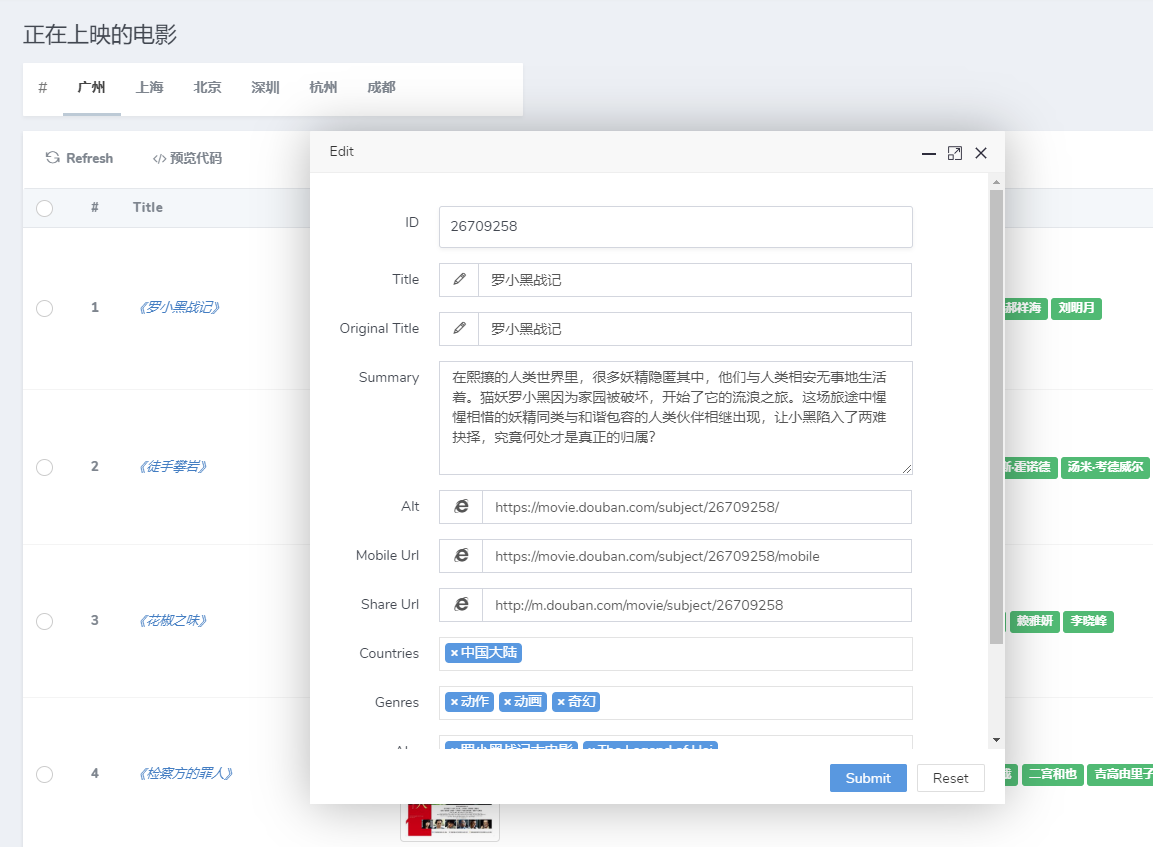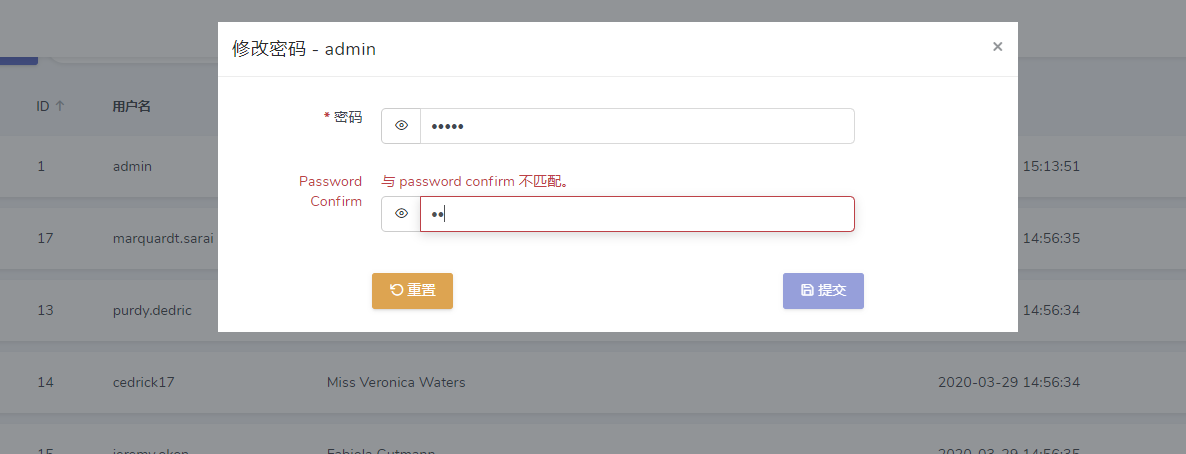Form pop-up
Data Form Popups
The Form::dialog method can be used to quickly build a data form-based form popup, adding only a few lines of code.
{tip} The form popup is based on the following principle: the
createandeditpages are used to retrieve the built formHTMLcharacters, and then theHTMLcharacters are rendered using a popup plugin. If a newjsscript needs to be loaded in the meantime, it will wait until the script is loaded and then execute the form initializationjscode.
Simple example
opens form pop-up
<?php
use App\Http\Controllers\Controller;
use Dcat\Admin\Form;
use Dcat\Admin\Layout\Content;
class ModalFormController extends Controller
{
public function index(Content $content)
{
return $content
->header('Modal Form')
->body($this->build());
}
protected function build()
{
Form::dialog('Add new roles.')
->click('.create-form') // Binding click button
->url('auth/roles/create') // Form page link, this parameter is replaced by the "data-url" attribute of the button.
->width('700px') // Specify the width of the popup window, fill in the percentage, default 720px
->height('650px') // Specify the height of the popup window, can fill in the percentage, default 690px
->success('Dcat.reload()'); // Refresh page after adding success
Form::dialog('Editing roles')
->click('.edit-form')
->success('Dcat.reload()'); // Refresh the page after editing the success
// When you need to bind different links to the same "class" button, put the link in the button's "data-url" attribute.
$editPage = admin_base_path('auth/roles/1/edit');
return "
<div style='padding:30px 0'>
<span class='btn btn-success create-form'> New Form Popup </span>
<span class='btn btn-blue edit-form' data-url='{$editPage}'> Edit Form Popup </span>
</div>
";
}
}Form building and saving data
<?php
use App\Admin\Repositories\Role;
use Dcat\Admin\Controllers\HasResourceActions;
use Dcat\Admin\Form;
use Dcat\Admin\Layout\Content;
use Dcat\Admin\Admin;
class RoleController
{
use HasResourceActions;
/**
* Edit interface.
*
* @param mixed $id
* @param Content $content
*
* @return Content
*/
public function edit($id, Content $content)
{
return $content
->header(trans('admin.roles'))
->description(trans('admin.edit'))
->body($this->form()->edit($id));
}
/**
* Create interface.
*
* @param Content $content
*
* @return Content
*/
public function create(Content $content)
{
return $content
->header(trans('admin.roles'))
->description(trans('admin.create'))
->body($this->form());
}
/**
* Make a form builder.
*
* @return Form
*/
protected function form()
{
return Form::make(new Role(), function (Form $form) {
$form->display('id', 'ID');
$form->text('slug', trans('admin.slug'))->required()->prepareForSave(function ($value) {
return $value;
});
$form->text('name', trans('admin.name'))->required();
$form->tree('permissions')
->nodes(function () {
$permissionModel = config('admin.database.permissions_model');
$permissionModel = new $permissionModel;
return $permissionModel->allNodes();
})
->customFormat(function ($v) {
if (!$v) return [];
return array_column($v, 'id');
});
$form->display('created_at', trans('admin.created_at'));
$form->display('updated_at', trans('admin.updated_at'));
});
}
}result

Functional interface
The form popup must be tied to a clickable page element that is clicked to bring up the popup.
set popupTITLE
$modal = Form::dialog('TITLE');bind click button
You can bind a clicked button via the ModalForm::click method, which will bring up a popup when the button is clicked.
Form::dialog('TITLE')
->click('#click-button');Set URL
If you are creating a form, you can get the url of the form template by setting it as follows
Form::dialog('新增角色')
->click('.create-form')
->url('auth/roles/create');If it's an edit type form, multiple URLs are required because the content of the form that pops up with each button clicked is different, so each button has a different link.
At this time, a link set by the ModalForm::url method is no longer sufficient, so you need to save the url on the data-url property of the clicked button:
Form::dialog('编辑角色')
->click('.edit-form')
->success('Dcat.reload()'); // Refresh the page after editing the success
// When you need to bind different links to the same "class" button, put the link in the button's "data-url" attribute.
$editPage1 = admin_base_path('auth/roles/1/edit');
$editPage2 = admin_base_path('auth/roles/2/edit');
return "
<div style='padding:30px 0'>
<span class='btn btn-blue edit-form' data-url='{$editPage1}'> Edit Form Popup1 </span>
<span class='btn btn-blue edit-form' data-url='{$editPage2}'> Edit Form Popup 2 </span>
</div>
";Form save success callback
The success method can be used to set the js code that will be executed after the form saves the success, and there is a response variable in the scope of the js code.
Form::dialog('Editing roles')
->click('.edit-form')
->success(
<<<JS
// Print the server response data
console.log(response);
// Prompt success information
Dcat.success(response.message || 'Save success');
// Refresh the page after saving the success
Dcat.reload();
JS
);Form Save Failure Callback
Through the error method, you can set the js code that will be executed after the form fails to save, and there is a response variable in the scope of this js code, through which you can get the json data returned by the server.
Form::dialog('Editing roles')
->click('.edit-form')
->error(
<<<JS
// Print server response data
console.log(response);
JS
);Callback after form save
The saved method allows you to set the js code to be executed after the form is saved:
successA value of true means the success is saved, otherwise it fails.responseThejsondata returned by the server
Form::dialog('Editing roles')
->click('.edit-form')
->saved(
<<<JS
// Print server response data
console.log(response);
if (success) {
console.log('Save success');
} else {
console.log('Save failed');
}
JS
);Forced refresh
Pull new template data from the server each time you click a button.
Form::dialog('Editing roles')
->click('.edit-form')
->forceRefresh();Set Popup Width and Height
Form::dialog('Editing roles')
->click('.edit-form')
->dimensions('50%', '400px');
// or
Form::dialog('Editing roles')
->click('.edit-form')
->width('50%')
->height('400px');Tool form pop-up
The popup function of data form is usually more complicated to implement with a resource controller, so the system has a built-in popup function.
